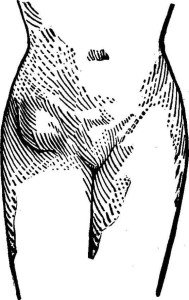
The femoral hernia is similar to the direct inguinal hernia but originates below the inguinal ligament and into the artery and inferior epigastric vein. The hole is usually small femoral, hernia will have a narrow neck. The hernia sac may contain only preperitoneal fat or contain only liquid.
A femoral hernia is always acquired. It is more common in women than in men and rare in children. It tends to be complicated by strangulation.
The femoral hernia appears as a small swelling or lump to the root of the thigh appearing effort and reducing supine. Most of the time, it shows no other symptoms.
The first clinical presentation may be the throttle: pain at the root of the thigh with nausea with general malaise, exaggerated by the extension of the thigh and calmed by the bending. Examination shows a small mass irreducible and painful to the upper portion of the thigh.
The treatment is surgical and should be applied because of the high risk of strangulation of this type of hernia. It consists of a resection of the hernia sac closure of the hernial orifice.
